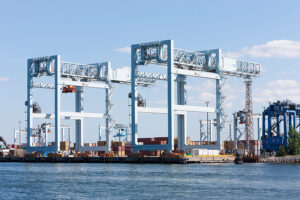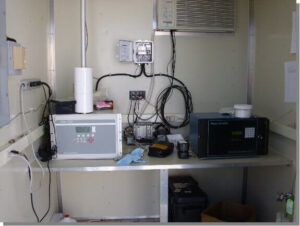Client: Massachusetts Port Authority
Location: Various
Under an open-ended contract, EA performed a variety of air quality services at various marine and airport facilities operated and managed by the Massachusetts Port Authority (Massport).
 Air Emission Inventory—EA prepared a comprehensive baseline air emission inventory of all sources located at the Port of Boston including ocean-going vessels, harbor vessels, cargo handling equipment, vehicles, and stationary sources. Specific facilities in the inventory included Autoport (Moran Terminal); Black Falcon Cruise Terminal and Berth (including cement berth); Conley Container Terminal; Constitution Marina; East Boston Marina and Shipyard; East Boston Piers; Fargo Street Terminal; Fish Pier and Berths; International Cargo Port (88 Black Falcon); Medford Street Terminal; Mystic Piers # 48, 49, and 50; North Jetty/Massport Marine Terminal (including seafood processing); World Trade Center (Berth only); Mystic Pier 1; and Boston Line (building and boats). The pollutants characterized included criteria pollutants (NOx, volatile organic compounds, PM2.5, PM10 and DPM, CO, SO2, GHG, and CO2 equivalent); a Scope 1 and 2 GHG analysis was performed in accordance with the emerging ISO 14064 standards and guidance.
Air Emission Inventory—EA prepared a comprehensive baseline air emission inventory of all sources located at the Port of Boston including ocean-going vessels, harbor vessels, cargo handling equipment, vehicles, and stationary sources. Specific facilities in the inventory included Autoport (Moran Terminal); Black Falcon Cruise Terminal and Berth (including cement berth); Conley Container Terminal; Constitution Marina; East Boston Marina and Shipyard; East Boston Piers; Fargo Street Terminal; Fish Pier and Berths; International Cargo Port (88 Black Falcon); Medford Street Terminal; Mystic Piers # 48, 49, and 50; North Jetty/Massport Marine Terminal (including seafood processing); World Trade Center (Berth only); Mystic Pier 1; and Boston Line (building and boats). The pollutants characterized included criteria pollutants (NOx, volatile organic compounds, PM2.5, PM10 and DPM, CO, SO2, GHG, and CO2 equivalent); a Scope 1 and 2 GHG analysis was performed in accordance with the emerging ISO 14064 standards and guidance.
 Diesel Emission Reduction Act (DERA) Program Support—EA assisted in the development of a DERA Grant Application for Massport. As part of the project, our staff calculated emissions from a variety of mobile sources including the vehicle fleet, off-road equipment, rubber-tired gantry cranes, generators, and marine vessels. It was determined that the most attractive option from a cost-effective standpoint would be for the retrofitting of commercial marine tugboats owned and operated by one of Massport’s tenants. The DERA grant was prepared to repower the vessels and provide new on-board electrical generators.
Diesel Emission Reduction Act (DERA) Program Support—EA assisted in the development of a DERA Grant Application for Massport. As part of the project, our staff calculated emissions from a variety of mobile sources including the vehicle fleet, off-road equipment, rubber-tired gantry cranes, generators, and marine vessels. It was determined that the most attractive option from a cost-effective standpoint would be for the retrofitting of commercial marine tugboats owned and operated by one of Massport’s tenants. The DERA grant was prepared to repower the vessels and provide new on-board electrical generators.
Logan Airport—EA took over the ambient air monitoring program from a non-performing consultant who encountered significant issues in the first year of monitoring. This work included critically evaluating the Year 1 monitoring program and recommending and implementing significant program modifications, including revision of work plans, quality assurance project plan, and standard operating procedures, which have yielded substantial cost savings and value. Innovations implemented by EA include:
- Implementation of a telemetry system at the three primary monitoring location stations to provide real-time beta attenuation monitor, aethelometer, and meteorological station data through an EA-developed web portal. The advantages of the telemetry system included real-time monitoring of system performance to ensure all units are operating properly, real-time data downloads, and immediate access to data for project stakeholders (i.e., Massport, regulators, and the public). This system significantly reduces down time when units are not operating properly, thereby maximizing data collection and improved “transparency” with stakeholders.
- Previous efforts relied solely on rented specialty equipment, which was often not calibrated or functioning properly, thus resulting in down time or data gaps. EA recommended the purchase of air monitoring units that were previously rented—the purchase versus rental costs over the life of expected monitoring saved approximately $20,000 annually.
- Passive sampling was conducted during the first year of monitoring. Passive samplers were set up at 8 satellite locations in addition to 3 primary stations. Problems were encountered with these sampling procedures throughout the year, including increased detection limits, data that did not realize trends, and high costs for unreliable data. On behalf of Massport, EA negotiated with the Massachusetts Department of Public Health and Massachusetts Department of Environmental Protection to omit the passive sampling requirements, resulting in a program cost savings of $17,000 annually.
 The monitoring program occurred for 1 year and monitored a range of airborne contaminants in a complex, urban environment. An extensive monitoring program was established using both real-time and periodic sampling. An integral part of the monitoring program was the development of a quarterly report and an annual summary report covering the 12-month monitoring period.
The monitoring program occurred for 1 year and monitored a range of airborne contaminants in a complex, urban environment. An extensive monitoring program was established using both real-time and periodic sampling. An integral part of the monitoring program was the development of a quarterly report and an annual summary report covering the 12-month monitoring period.
EA supported Massport throughout the project with regulatory review and negotiations and with public meetings.
